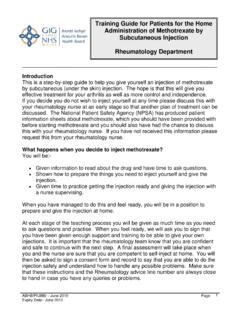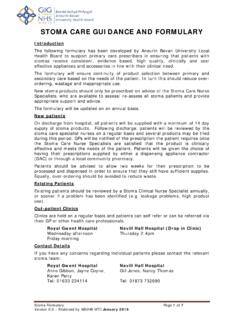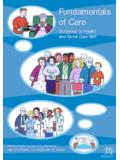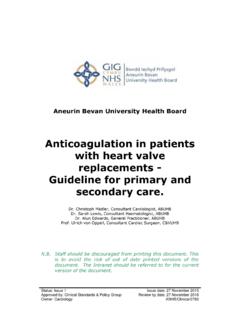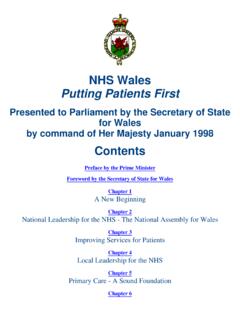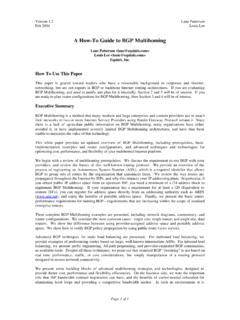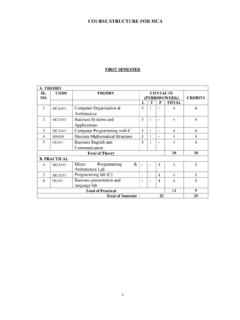Transcription of bringing the nhs and local government together A …
1 bringing the nhs and local government togetherA practical guide to integrated workingA practical guide to integrated 8/2/08 12:48 pm Page 1 What is the integrated Care Network?The integrated Care Network (icn) provides information andsupport to frontline nhsand local government organisationsseeking to improve the quality of provision to service users,patients and carers by integrating the planning and delivery ofservices. Key to the role of the icnis facilitating communicationbetween frontline organisations and government , so that policyand practice inform each other effectively. The icnis part of theCare Services Improvement Partnership (csip).Care Services Improvement Partnershipcsipwas launched on 1 April 2005 after a formal publicconsultation. Our main goal is to support positive changes inservices and the well-being of: people with mental health problems people with learning disabilities older people with health and social care needs children and families people with health and social care needs in the criminal advice on partnerships and integration that cut acrossall services in health and social care.
2 It works closely with othernetworks and programmes across csipto ensure synergy of the guideThis is an updated version of integrated working : A guide (2004).The contents of both versions have been devised and written byPeter Thistlethwaite, who is a specialist R&D consultant in integratedcare. Like its predecessor, the new version has been designed andedited at Dartington Social Research Unit by Kevin Mount. We are grateful to Julia Thompson, Jeremy Porteus, ChrisMahony, Ed Harding and Robin Lorimer of icnfor their supportand ingenuity in helping us develop the 19/2/08 2:50 pm Page 2bringing the nhs and local government togetherA practical guide to integrated working2a practical guide to integrated working3a practical guide to integrated workingForewordThere comes a point when the value of an idea is so well-established that practical advice on implementation is moreimportant than another slice of theory. That is the thinkingbehind this document which seeks to help organisations inthe NHS and local government deliver integrated services for the benefit of local users of the Department of Health, cohesion and co-ordination inadult social care are among the key priorities for 2008.
3 That,of course, reflects the continuing Ministerial emphasis onintegration as outlined in Putting People First, the concordatbetween central and local government published in Decemberwhich set out a shared vision and commitment to thetransformation of adult social care. It said: Ultimately, everylocality should seek to have a single community-basedsupport system focussed on the health and well-being of thelocal population. Binding together local government , primarycare, community-based health provision, public health, socialcare and the wider issues of housing, employment, benefitsadvice and education/training. This guide a timely update to the 2004 integrated CareNetwork (ICN) publication is a response to thesechallenges. The benefits of integrated care systems inimproving outcomes for services users are clear thequestion is how best to achieve them. This guide bringstogether the latest changes in policy and best practice, andaims to support organisations in the NHS and localgovernment along the road to practical guide to integrated workingIntegration is not easy.
4 The circumstances and preferences ofeach service or locality will differ considerably, and policy andbest practice will continue to evolve. For example, thoseplanning and delivering services will have to consider hownew initiatives such as Individual Budgets can best beimplemented. Correspondingly, this guide cannot remainwholly static. The integrated Care Network will be providingupdated content and features through its with commentary, user input andnetworking warmly invite you to join the integrated Care Network andtake Horn National Director ofCare Services Improvement 19/2/08 1:42 pm Page 4 How to use the guide 6 What integration should mean for your locality or service 8 Self assessment: some integration benchmarks 10 Part One: Knowing more about integration131 Agreeing what integration means152 The journey to integration 213 How evidence of what works can help244 Understanding the potential benefits32 Part One in summary36 Part Two: Making it happen375 Community-wide governance396 Commissioning together497 Providing integrated services618 Putting integrated care into practice77 The guide in summary89pen pictures1 Establishing a user focus 342 Barnsley 423 Herefordshire 434 Peterborough 515 Knowsley 566 South Tyneside 577 Commissioning for prevention and early intervention588 Torbay Care Trust659 Telford and Wrekin Children s Services6910 Sandwell Mental Health7011 Sedgefield7312 Castlefields Surgery, Runcorn83 Contents6a practical guide to integrated workingIf you have the power to change policy or local practice, thenthis guide has been written for people like you.
5 Integrationneeds leaders at all levels who can rise above their usual rolesand responsibilities, and, with support from their employers,work with a range of professionals and organisations toimprove outcomes and experiences for users. The guide aimsto provide you with the necessary practical to read the guide from start to finish, although you canpick and choose from the sections. The broad aim is to helpyou to gather a picture of where you stand locally with theintegration agenda, so that you can map out and sustain yourown development process. So this is purposely more of atraveller s guide than a textbook; the intention is to provide acarefully sequenced and organised combination of ideas andpractical guidance, supplemented by: focal points from national policymessages fromresearchpen pictures of early adopters of integrationYou can get an early feel of what a more integrated approachmight mean by assessing your locality or service against theintegration benchmarksgiven on pages 10 and 11.
6 This mayalso help you to decide where the guide can help you is no single route to follow. The guide providesstimulus and ideas to support well thought-out local choicesabout is no prescription: a variety ofapproaches to suit local conditions and histories will continueto be appropriate. In some services frontline practice mayactually be ahead of official local policy and strategy: part ofthe message is to encourage all leaders to promotecommunication across and between organisations, to makeplans in response to local needs and, in the best sense of theword, to organises four networksin addition to the IntegratedCare Network. One is devotedto Leadership and TeamworkDevelopment and provides anavenue to a wide range ofopportunities for learning andpractice exchange and accessto online to use the guideThe different informationstrands use these threecolours to use the guideThe guide has been designed to be used in association withthe with a special section devoted to the you ll find electronic versions of the book in Word(.)
7 Doc) and Acrobat (.pdf ) formats and also numerous links toother online resources and the main, it will be easier to read the guide using thepublished paper version. But the icnwebsite pages provide amore versatile avenue to other material, and during 2008development of those online resources will be , to get the latest information relevant to the guide , werecommend a regular visit to: indicate the more important online connections we haveused the icon shown in the margin. In the .pdf version of theguide these prompts are given in the same page position but aslive hyperlinks: just click the hyperlinks to go to the referencedmaterials. And all the references can also be found in one placeby clicking the reference tab on the website guide home also give direct links to the Every Child Matterswebsite: is integrated care? integrated care refers to advanced arrangements for jointworking. In the context of this book the focus is on health andlocal authority care provision for children and adults, which attimes will include Housing and Leisure services.
8 The broadcontext of local Area Agreements and joint strategic needsassessment which must underpin such collaboration is set inSection 5 of this for ChildrenEvery Child Matters8a practical guide to integrated workingThe purpose of integration is to improve service userexperience and outcomes. This is done by minimisingorganisational barriers between different services, andbetween services and commissioners. Promoting better public services through integration has beenthe clear intent of recent government legislation and policy andis now regarded as the norm rather than something exceptionalor unusual. Key recent documents such as Every Child Mattersand the Children s Act 2004 which followed it, the DH WhitePaper Our Health, Our Care, Our Say,(2006) and the LocalGovernment White Paper Strong & Prosperous Communities(2006) signal the clear intent for higher standards and moreintegrated provision for service users. This has been reinforcedby Putting People First(2008), a ministerial concordat on adultsocial care services, which places integration centre stage in thepolicy drive towards greater personalisation of how integrated is care planning and provision in yourlocality and service?
9 ? Is it in place at every level fromstrategic vision to day-to-day practice? How much progresshas been made to ensure that users get the benefits ofintegration, for example: the easiest access to advice and help the simplest processes for assessment and decision-making the swiftest delivery of whatever help is needed the least risk of errors and unnecessary stages in theprocess (and no passing the buck) the maximum opportunity for controlling eventsthemselves?All of these are features of an effective system of care, and allare difficult to optimise without a local commitment topartnership and integration from politicians, directors, policymakers, managers and practitioners. They also require theengagement of users and carers. The key benefits have beendemonstrated in research and in case study evaluations of theprovision of care, some of which are highlighted in this guide . What integration should mean for yourlocality or service9what integration should mean for your locality or service The integrated Care Network was brought into being to supportthe realisation of these aspirations.
10 The five target areas fordevelopment it established form core elements of the rest ofthis guide : access, reshaping services, community engagement,reshaping resource flows and workforce messages have featured strongly in policy and researchpapers for years, but many readers will acknowledge that localprogress has been uneven, and that the obvious barriers mayseem insuperable despite the best efforts of professionals andplanners. Whilst certain specially-funded schemes may havebroken the mould ( the Partnerships for Older Peoplepilots and Sure Start), the mainstream way of doing things ismuch more resistant to integration. Delivering the benefits ofintegration can be made to sound very easy, but it requires ahuge commitment to a programme of change and there willbe daily distractions and pressures in the , this guide cannot be neutral. It makes the case forintegration, and its purpose is to help it into practiceeverywhere. Beneficial progress has been made all over thecountry in co-ordinatingservices over many years, but thelimitations and frailty of such arrangements are clear, and themore robust and sustainable benefits of the integrated approachhave now been demonstrated.

